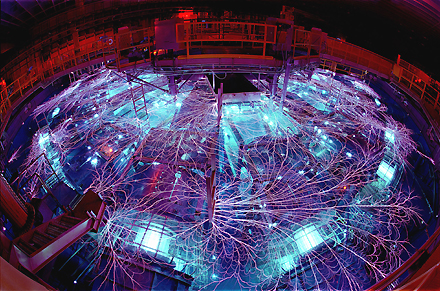Forgive me for not posting lesson two yet. I was stricken with a nasty stomach flu last Thursday. Once I get my class caught up, ill post lesson two.
Ill keep you posted.
Tuesday, April 19, 2011
Wednesday, April 13, 2011
The Z-Machine, a Real World Example
On the subject of yesterday’s lesson, power, I thought I would briefly talk about one of the world’s most extravagant demonstrations of electrical power, the Z-Machine at Sandia National Laboratories. For those who have never heard of it, the Z-Machine is basically a very large energy storage device and it is used to produce extremely hot plasma, focused onto a very tiny area, in an attempt to create a nuclear fusion reaction. This machine is capable of firing pulses of energy close to 290 terawatts. That’s 290,000,000,000,000 watts! That's 80 times the world's electrical power! But you may be asking yourself, how this is possible?
The Z-Machine
The answer comes down to the unit time in which the energy is discharged, and that time is equal to about 100 nano seconds. To give you an idea of how short of a time frame that is, 100 seconds is to 100 nano seconds as the diameter of the earth is to the width of a human hair.
The interesting thing about this is how much energy is actually consumed during this event.
If you remember from yesterday’s lesson, power is equal to a change in energy per change in time (dw/dt). Sparing everyone the mess of a derivation of the equation, the expended energy can be written as..
where
w = the work done in joules
p = the power in watts
Δt = the change in time
Now we have an expression for the energy consumed within a time frame, where Δt is the change in time. Now you simply fill in the blanks! Remember that the Z-Machine fires a 290,000,000,000,000 watt pulse in 100 nano seconds.
We get about 29 mega joules. It may not seem like it, but that's actually not very much energy considering the power discharged.
Well that was longer than intended. Hope you found that real world application interesting! Lesson two will be posted later this week.
Monday, April 11, 2011
Lesson 1
Chapter 1 - Circuit Variables
1.6 - Power Calculations
We will be starting off in section 1.6, Power and Energy on page 14.
Power and energy calculations are very important in circuit analysis. This may seem like common sense, but this is so due to the fact that all practical devices have limitations on the amount of power they can take. Therefore, as engineers, it's important to understand these limitations.
Power can be related to voltage an current by means of a simple connection as follows; power is the amount of energy per unit time, and can be expressed as the derivative...
where
p = power in watts
w = energy in joules
t = time in seconds
Notice, a watt (W) is given by joules per second. While this connection is important, in and of its self, it's not very useful . Make it useful, recall from your physics class that voltage can expressed in energy per unit charge...
where
v = voltage in volts
w = energy in joules
q = charge in coulombs
and recall that current can be expressed in terms of charge per unit time...
where
i = current in amperes
q = charge in coulombs
t = time in seconds
Putting these facts together, notice that if the dq terms were canceled would be left with our original definition for power, but merely substituting terms we get something new and useful...
where
p = power in watts
v = voltage in volts
i = current in amperes
Now that's more useful. We can now relate the voltage across, and the current through a circuit element to the amount of power that it consumes (positive power) or generates (negative power).
And on that note there is one more important connection that must be made. The sign of power is based on the movement of charge through voltage drops and rises, i.e. as a positive charge moves through a voltage drop, it loses energy. And if it moves through a rise in voltage, it will gain energy. This rule for determining the sign of power is called passive sign convention for power elements. So to sum it up, if current enters the positive terminal, or leaving the negative terminal of any element, power is positive. If current enters the negative, or leaves the positive terminal of an element, the power is negative.
For example, consider the black box below.
If the voltage across the boxes terminals is equal to 12 volts (v = 12V) and the current into it is equal to 3 amps (i = 3A), how much power is being absorbed or dissipated inside the black box and what is its sign? What if the voltage is negative? Ill post the answer next lesson.
That wraps it up for today's lesson. If you have the book, try problems 1.12, 1.17, and 1.24. For next time, start reading Chapter 2, we are just going to jump right in.
If you have any questions, PLEASE feel free to post them in the comments!
Hello World!
For those who aren't my students, this is going to be a Techblog dedicated to electrical engineering and other nonsense, as the title implies. It will mostly contain lessons and learning resources for my students, but I am sure it will also serve well as a reference to any aspiring electronics aficionado.
The text I will be covering is Electric Circuits (8th) by Nilsson. The first lesson will be posted this week.
The text I will be covering is Electric Circuits (8th) by Nilsson. The first lesson will be posted this week.
Subscribe to:
Posts (Atom)






